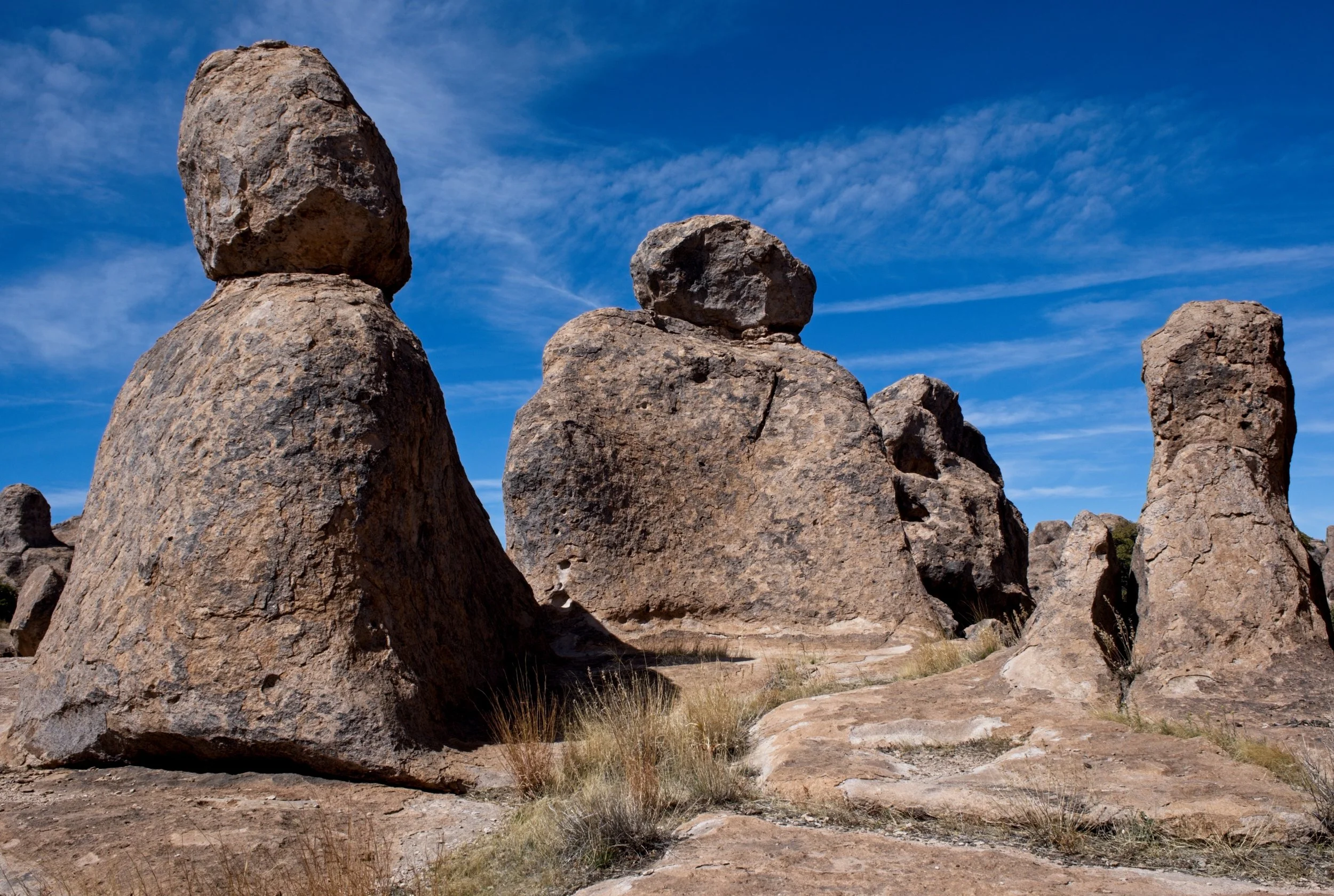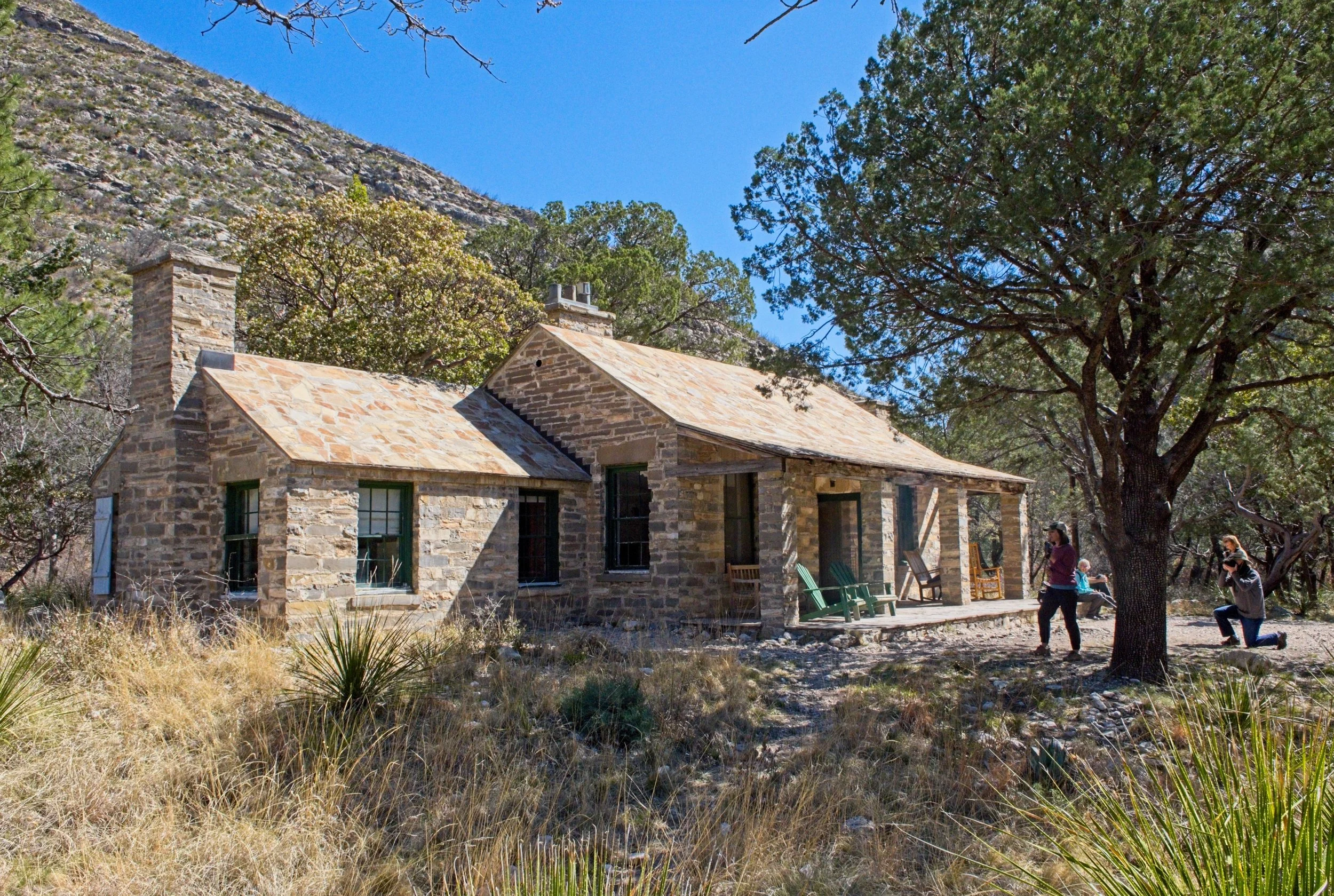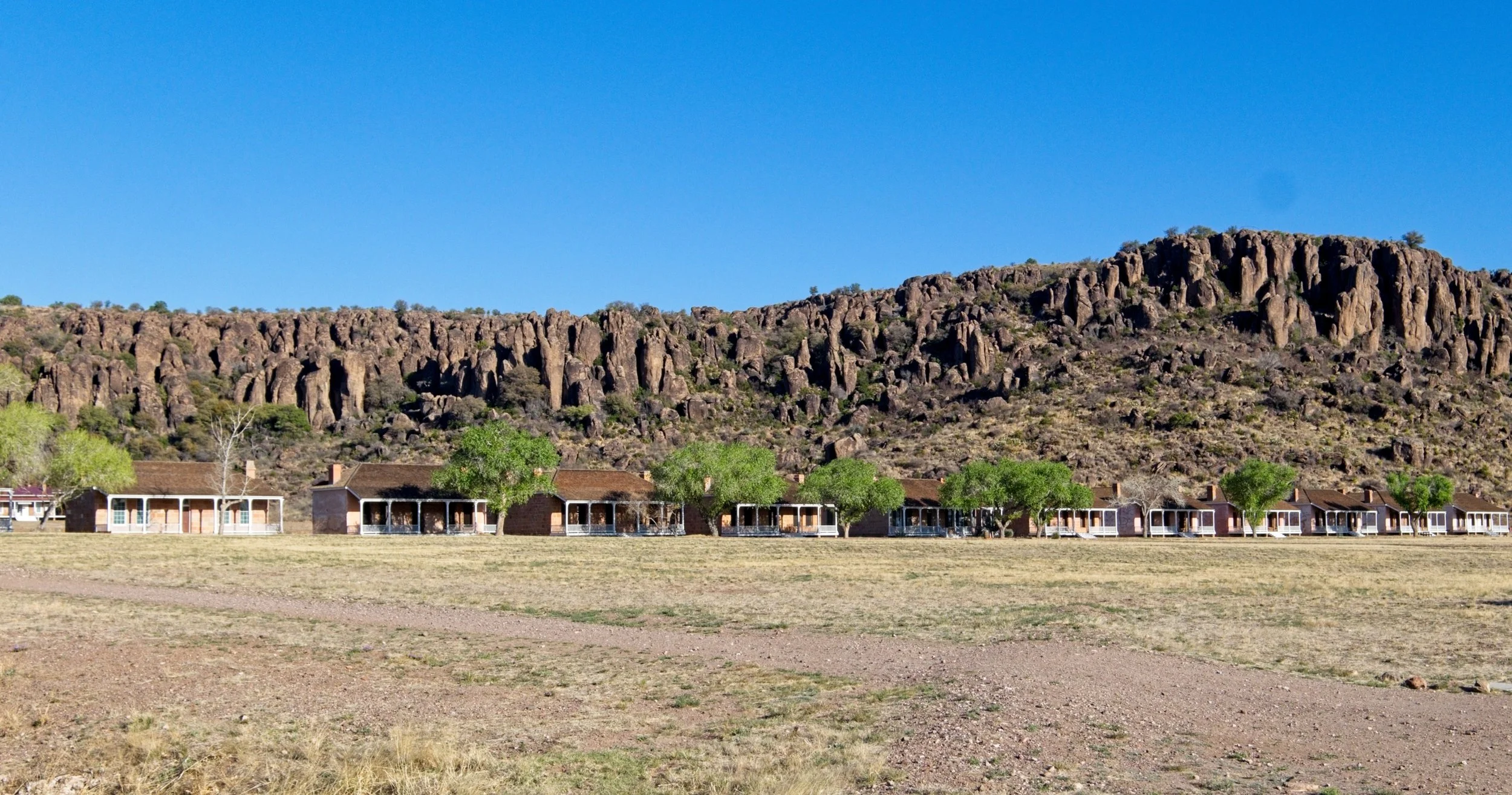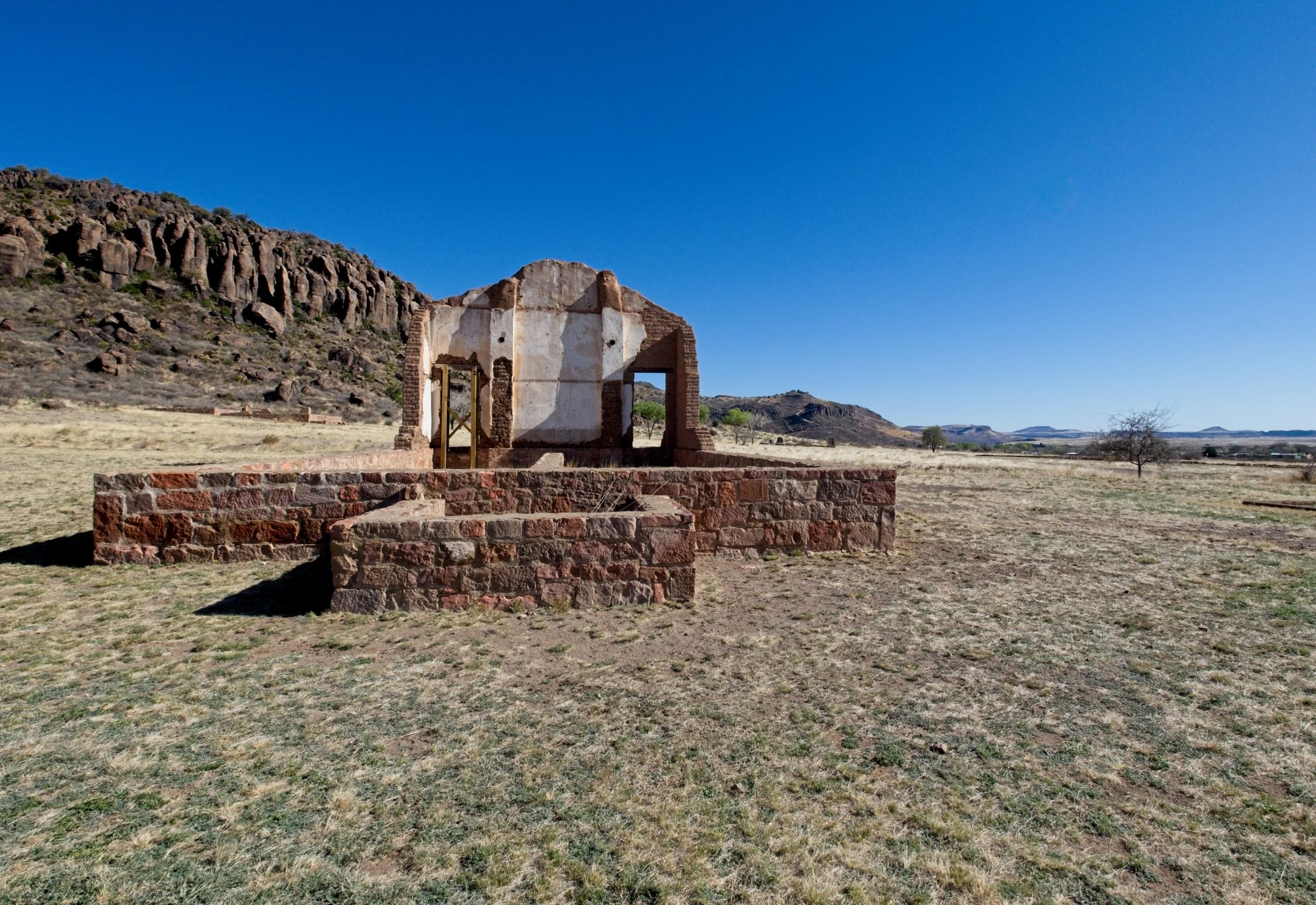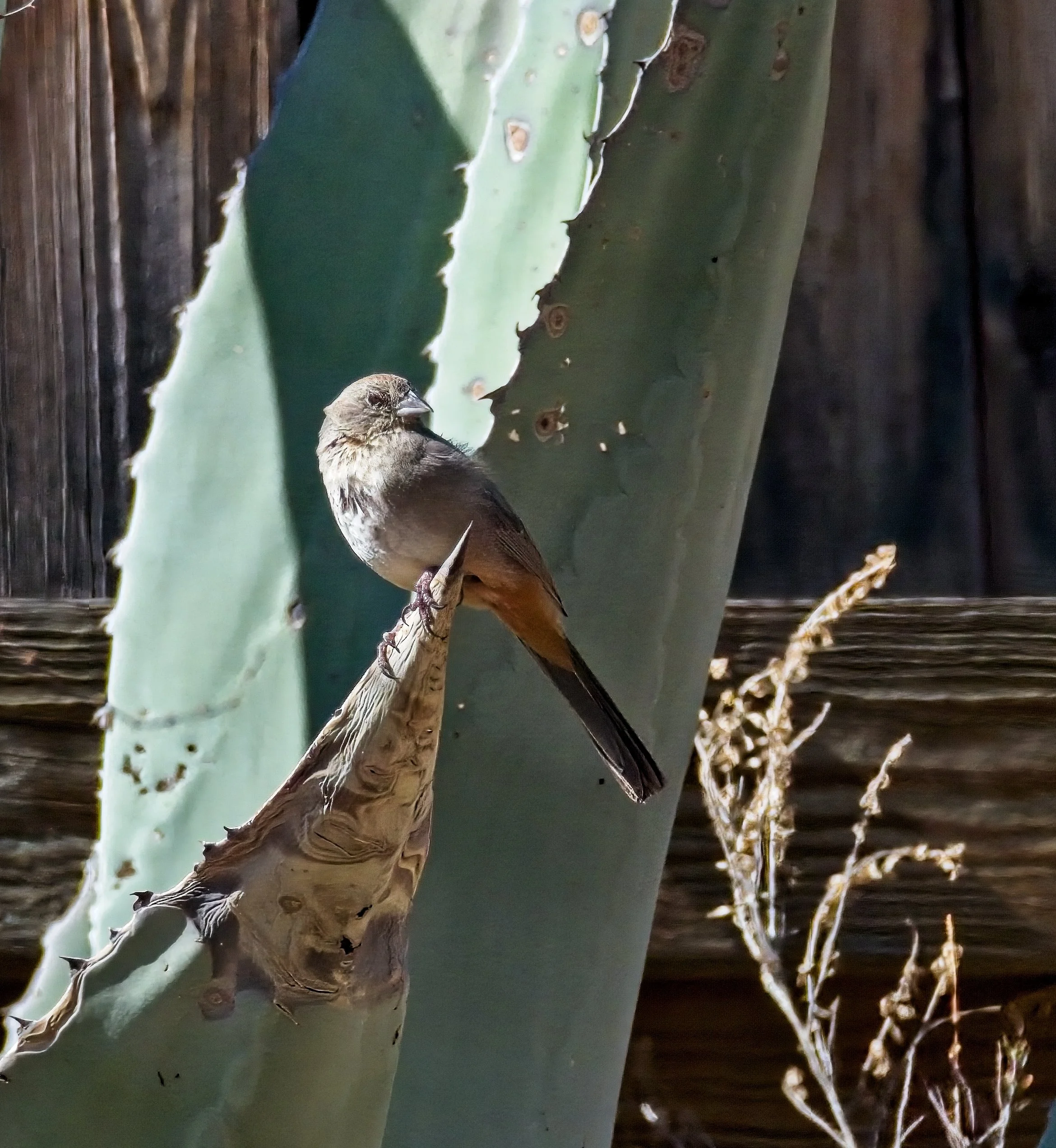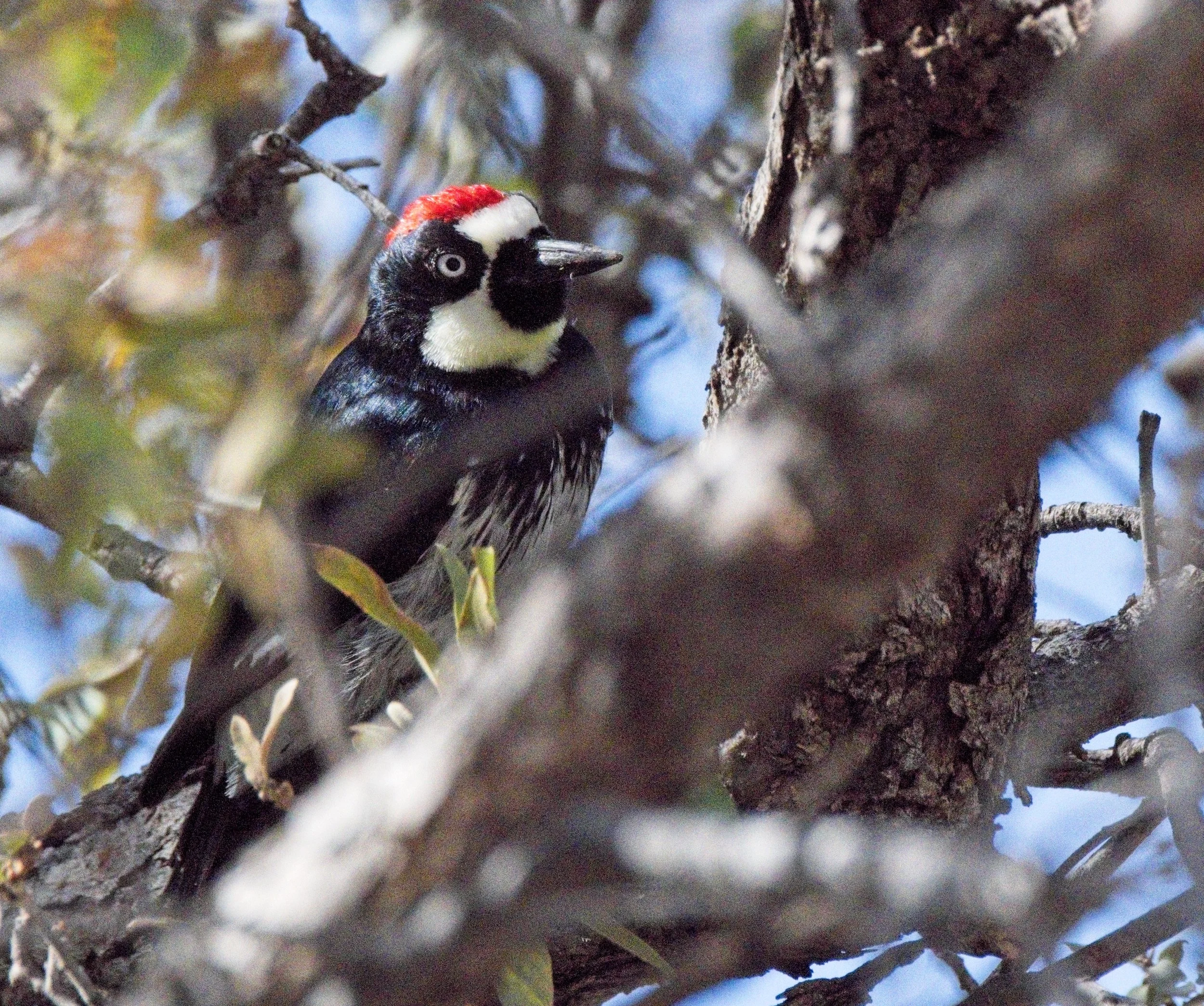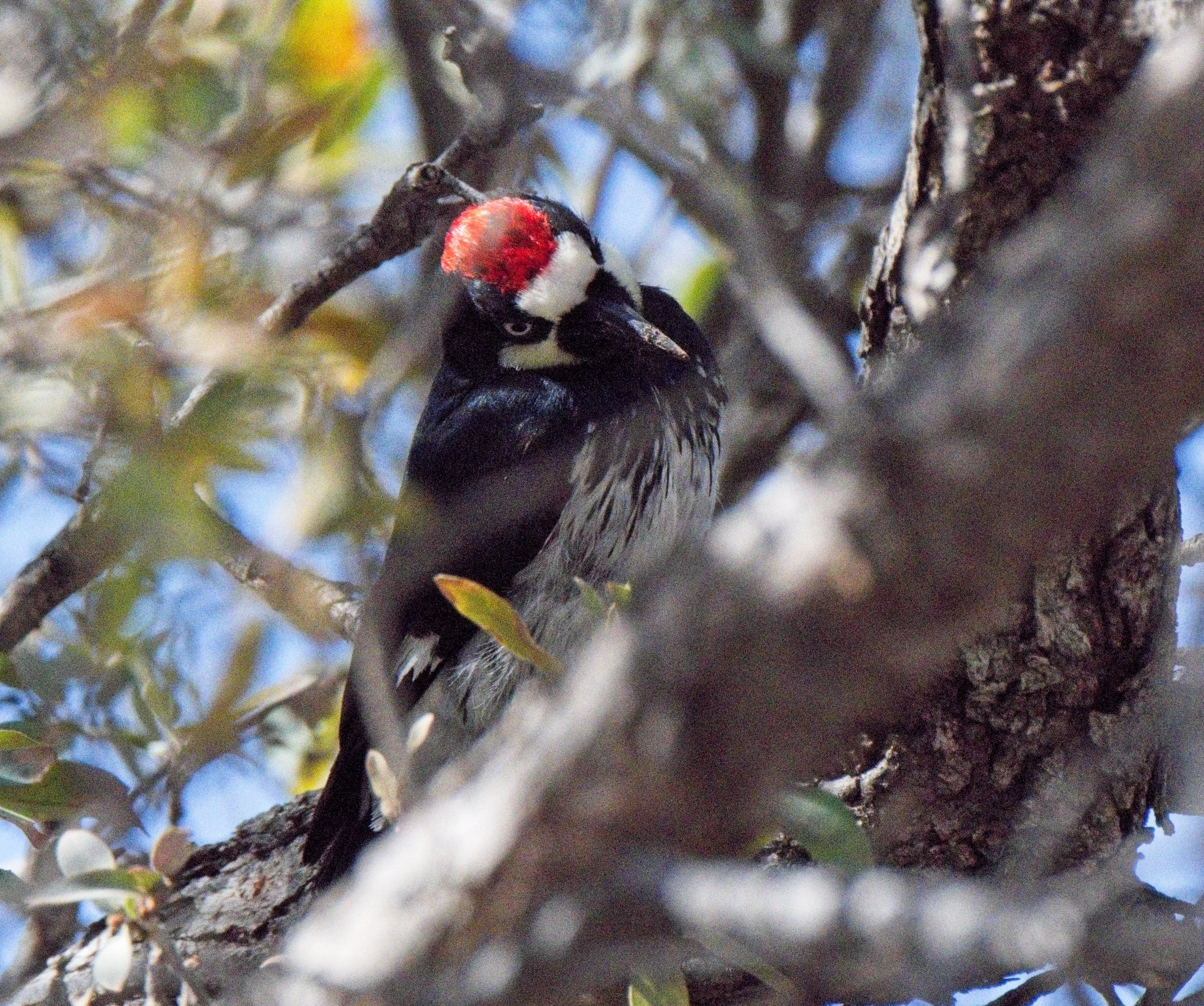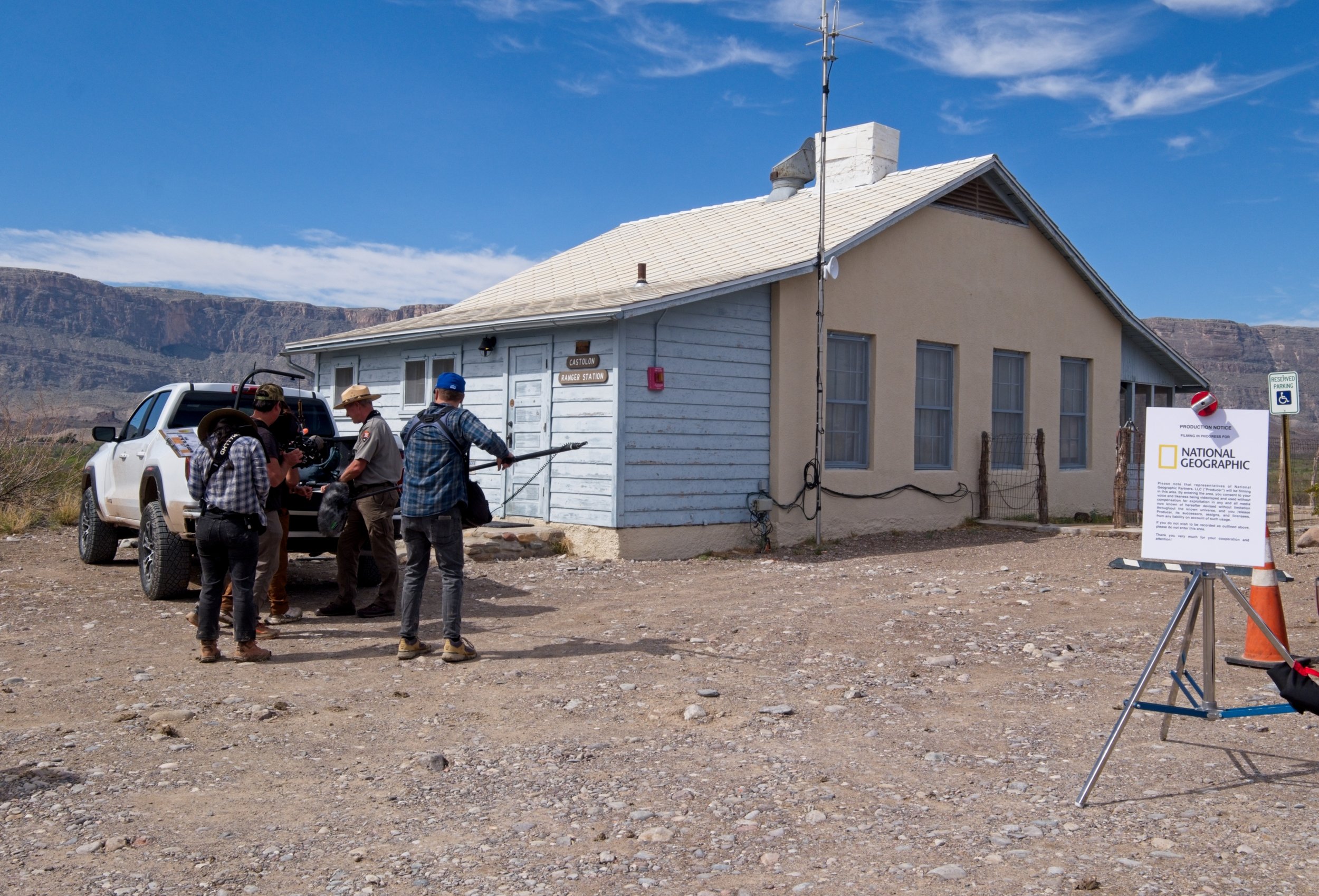This is a Cliff Chipmunk. I photographed him at the campsite at Chiricahua National Monument. Not sure what it was at first because of the large fluffy tail, i sadly misnamed it a squirrel because there are some unique ones in the area. However the ranger and I delved into a book or two and discovered that it was a neat chipmunk. You never know what you will see out your door when your door is in lots of places.
City of Rocks State Park /
City of Rocks is a New Mexico State Park in the southern portion of the state 35 miles north of Deming. We camped here to enable the visit to Gila Cliff Dwellings but it is unique as well. There are, we were told, six places in the world where rocks appear like this. Here they are placed in close proximity and scattered over a half mile of desert. Many of them more than 40 feet tall you can see quickly why people saw this like a city and it is easy to get lost in the maze too. We enjoyed a walk among the rocks, though no bagel shops no coffee shops and no ice cream, not much of a city.
Smith's Spring /
Hiking in the high desert into the mountain canyon I was surprised to find how lush Smith’s Spring was, even a small waterfall. The water was clear and cold and filled several small pools. The trees were large and the cacti were less prominent. There were more flowers and the madrone tress were in bloom. A wonderful respite from the relentless sun and heat of the dessert.
National Park Unit #330 - Carlsbad Caverns National Park /
What can you say about a hole in the ground…. a lot! Carlsbad Caverns is on the same range as Guadalupe but into New Mexico. We arrived with a times entry at 9:30 and it was a busy place. There are two gift shops, a restaurant, movie and extensive museum above ground and some hikes that we did not take. We did walk into the cave, descending 0ver 950 - more than 90 stories, into the cavern and then began the 2 mile walk through the caves massive rooms. The light is low so going is careful but there are railings on both sides of the trail to keep you on the path. There are some fanciful names but most of the cave is low key, no colored lights, organs or animation. The famous bats that swirl out of the cave at sunset don’t occur in the winter - much to Cindy’s delight.
National Park Unit #329 Guadalupe Mountains National Park /
Guadalupe Mountains is a remote park in West Texas along the New Mexico boarder. GMNP is a vast wilderness. A major highway skirts the edge of the park for 40 miles including Carlsbad Caverns - same mountain range. So access is at three places along the highway. Many of the hikes are rugged and steep. We did a few - one 7 mile hike that Rusty and I did into a canyon with a very nice stone house built by McKittrick, the man who eventually gave much of the land for the park. We also did a trail to the old Butterfield Stage stop, Frijole Ranch, Smith Spring and a nature trail. We saw Texas madrone trees and alligator cypress tress along the trails. The wind was fierce gusting one time to near 60 MPH and steady over 24 MPH so the cool weather felt quite cold. It also dampened activity a bit. We camped with no services in the parking lot for a trail that NPS has designated for camping.
National Park #328 - Fort Davis National Historic Park /
Fort Davis has a lot of the buildings intact or restored. It is situated in a box canyon with the San Antonio trail from Mexico, a major early trade route, right in front of the fort that was designed to protect travelers on the trail. It served in two stages one pre-Civil War in a more rough, hastily built fort and post Civil War with much more permanent buildings. It including a chapel, barracks, large hospital, horse barns and facilities, officers quarters, commissary and lots more. After the war it was staffed mostly by the Buffalo Soldiers until is closed in 1882. The park is right in the town of Fort Davis across from the new (only) grocery.
Looking across the parade ground to the officer and civilian quarters. Hospital was behind them.
Remains of the chapel
A wagon of the era.
Sunday Scripture: Photo from Big Bend National Park /
New Birds! /
I saw the Acorn Woodpecker first at Big Bend NP ( see earlier post) and then again at Davis Mountain State Park. It is a very colorful bird. I also added the Common Blackhawk at the Rio Grande Village section of Big Bend. I saw a Rock Wren at Santa Elena Canyon at BBNP. Then at Fort Leaton Texas State Historic Park I saw my first Black Ladderback Woodpecker, (sometimes just Ladderback). I was also able to see it again at Davis Mountain at a bird blind that the park set up - really nice place with indoor and outdoor seating - lots of water and food for the birds and a backdrop of a grassy slope leading up the hill behind the blind. There I saw a Canyon Towhee, a Scotts Oriole and a Black-tailed Gnatcatcher, all three are new and several more I had seen only once before. Then at our campsite outside our window was a Vermilion Flycatcher! No photo but what a great find that Cindy spotted. On to Guadalupe Mountains NP where I met Frank Howe - who was just the state ornithologist for the state of Utah and Utah State professor of ornithology. Fortunately for me he was also a nice guy and willing to share the Identity of some birds I had seen but did not ID. So I added the Black-chinned Sparrow, the Townsend's Solitaire, the Say’s Phoebe, Pine Siskin and Cassin’s Finch. Wow and thanks Frank.
i also saw three mountain goats that came down the mountain to get a drink, a shy young deer and a family of Javelinas including a very young one with the group.
If you are keeping score those 13 new birds bring the total to 434!
Scott’s Oriole
Cassin’s Finch
Townsend's Solitaire
Canyon Towhee
Dreams /
There are a lot of old stations, old tourist stops and isolated houses along many of the roads of West Texas. Each of these represent a dream, a livelihood, helped raise families and sent kids to college but time, changes to travel and changing tastes leave only the shells along the highway.
# 327 - Big Bend National Park /
OK, I am overwhelmed with trying to do this on a single page. A massive park with four distinct parts and much more to see and do. It borders the Rio Grande river on the south for 118 miles and extends across more than 800,000 acres. We did not see it all in four days. Our sample included a bit of each zone but missed a lot of things in all of them. On the east we did three short trails and some of the history of the area, in the west we hiked the Santa Elena Canyon, it was spectacular and we did two old ranch hikes, an amazing overlook and some of the history of the area. In the central high mountains the scenery changed from desert to pine, oak and maple forested areas. Here we did lunch at the nice lodge, a 2 mile hike and some shorter trails. We also did Balanced Rock - see earlier post, and lots more. I found it an amazing place. More photos when I get the time at home to more carefully edit them
Big Bend National Park, Texas
Big Bend has Beautiful Sunrises
Rock Wren in Santa Elana Canyon
1500 Sheer Walls of Santa Elena and the Rio Grande
Oh Deer /
Yes, I know you can see deer in almost any urban back yard. BUT I watched this cautious mule deer (I think) come down a large mountain side alone and easing toward the pool where a refreshing drink of water awaited. Yet an abundance of caution, as the recent phrase went, kept him alert. I was well protected from his sight by a bird blind but I knew he was aware of me yet he came so close and then from about 20 feet - five from the water, just stared. There were lots of birds to and fro but at the last moment he turned and went back up the mountain. I hope he returned and got the needed drink. Special moment at Davis Mountain State Park in Texas.
The Great Race /
Actually not a race even though some of the kids were suggesting they race. All novice paddlers, their first time I think, but they listened well and seemed to be going reasonably straight. What an adventure for a group of middle or early HS kids. We saw the same group on a trail later. Very polite.
# 423 Acorn Woodpecker /
I saw this bird for the first time at Big Bend National Park in the Chisos Mountain area. One of my “targets for this trip and I was really excited to see it after the failure to photograph the Red Cockaded - though I have seen the latter before in Virginia. This is one of two positive ID birds so far with 3 more possible. I’ll have another next week. A roar of joy goes up across the land.
Rio /
This is Terlingua Creek where it curves left to meet the Rio Grande in Big Bend National Park. The 1500 foot cliffs on the other side of the Rio are in Mexico and the the Rio Grande flows between towering rock walls. We will hike into the canyon about 3/4 of a mile and it was a wonderland. I will eventually get to process some of those next week.
Sunday Scripture: Photo from Big Bend National Park /
MOOSE DOWN! /
Unfortunately we stumbled on a National Geographic film crew a few days ago. They were doing a multi-place show about Big Bend. Cadillac, recalling his glorious debut in film and thinking as only an addled Moose can, that since they had a director, camera & sound tech and even a gaffer and a grip, they must be the ones to shoot the Great British Baking Show. And he did not see Paul Hollywood so, taking no chances he stowed away in a light case. He took three pounds of Butterfingers, an old slice of bread, all my apples! and a can of soup. Good luck with the can. Of course they found him as they got into St. Louis. He started whining right away with his “need” for a very large, extra hot, spring onion latte and a stop at Ted Drewes for ice cream cause he was deprived for the trip. And where was the next bakery he could evalutate and did they keep Paul Hollywood’s special chair…..and are returning him postage due. We expect him some time in a week or so and he will have a lot of WORK to catch up his reviews and pay off his debt. Again.
King /
This is the barn on the King Ranch where the new Ford “King Ranch” series is introduced and photographed for the first time for the public. Then a commercial is shot on the property. King Ranch editions are in the Ford truck line. The King Ranch is a 1,000,000 acre conglomerate with everything from beef to cotton, to oranges and sod, to saddles and hunting. And lots of horses.
On Balance /
Rusty, Cindy and I hiked to Balance Rock in the Big Bend National Park. The hike was about 1 mile each way with the last 2 tenths pretty much of a rock scramble. Cindy did really well but it was a challenge. At the top a young women - who also had to tell three “older” people where the trail was took our photo, not sure what happened to the settings but this is what we got and we are appreciative of the memory. The most difficult park was on the 6 mile Grapevine “improved” dirt road. We will allow the park service their definition of improved but I will suggest it does not align with my definition. The 12 mile out and back took about 90 minutes.
Camping Recap - Week Eight, another bonus post /
We were again at three parks over the week, one state park, two commercial ones, unusual for us.
We spent one night at Seminole Canyon State Park, Del Rio, Texas. It was on a mesa with a good view but it was very cloudy and we had cold rain. The sites had gravel base with power and water and the table was under a shelter.
Our next night was at Marathon Motel and RV Park. The sites were on gravel but with a lot of mud seeping in because of the rain and snow, not a regular occurrence. The had full hook ups at a reasonable price and some unique features including a nice courtyard and great views. The laundry was difficult.
Finally at Study Butte, Texas, we spent four nights in the Paisano RV Park while we toured Big Bend National Park. It was very convenient to the West entrance and to the Santa Elena Canyon area, a jewel of a hike! The RV park is a step above the area with some nice touches, full serve and friendly hosts.
We are off for Fort Davis and Guadeloupe Mountains this week.
Desert Nursery /
Small cactus find a great start in the shelter of mesquite and some other rugged desert plants. The cactus grows and is protected in its most vulnerable stage by the host plant. As the cactus grows often the other plant will die. This is one of the cacti we saw in this stage of growth. This one is bursting with signs of spring.


